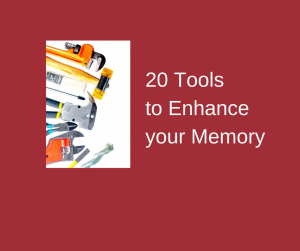(Note: Many links return to other articles by Marla Cummins on her site.)
For adults with ADHD, not being able to remember your intentions is what can sometimes get in the way of following through.
I know from plenty of personal experience with forgetting everything from the mundane to the important, it can be really frustrating.
But, rather than berate yourself because you think you should have a better memory, you can adopt workarounds to help you remember what you need and minimize your frustration.
Below I’ve curated a lengthy list of possible options you can apply to the various situations in your life. And, if you can think of more, please share below.
Short Term and Long Term Memory
First, a little bit about why you may have such a hard time remembering information at the time you need it.
One reason is that short term (working) memory is often weak in adults with ADHD.
- That is, you may not hold information long enough to follow through on it. So, you say to yourself, “I need to drop off that folder at Joe’s office before I leave.” Then you turn around to get your jacket, pack up and forget about the folder. All within the span of a few minutes!
- Because you do not hold onto information long enough it also does not enter your long term memory. So, it is lost to you until Bill says to you, “Hey, Lisa, I didn’t get that email you said you would send when I saw you in the hall yesterday.”
Challenges with long term memory are also common for adults with ADHD.
- This can mean that you have difficulty remembering your intention to do something in the future. So, as you are leaving the office you have this nagging feeling you are supposed to do something before going home. Not until you get home do you remember you were supposed to pick up the take-out!
- Also, you may have difficulty recalling information when you need it. You go to the meeting and can’t remember all the details of the report you want to share.
Bottom line. Your memory, like mine, may be more like Swiss Cheese than a trap door. That is ok, as long as you use some of the methods below to help you remember what you need when you need it.
 Remembering What You Want
Remembering What You Want
- Paper-Based Task Managers– If you are looking for a comprehensive paper-based system to manage your to-dos, try the Planner Pad.
Their web site is oudated but don’t be discouraged. See this article about why to use it.
- Electronic Task Managers You may opt for an electronic system to manage your to-dos. These range from the simple, like Remember The Milk, to the more comprehensive like Omnifocus, Nozbe, Toodledo or, Todoist.
- Put It Where You Can Do Something About It– For example, when you have books to return to the library, clothes to donate, etc. put them in the car where you can see them. That way you can take care of them when you are out and about. Could save you an extra trip.
- Just Do It!– If a task is going to take you less than 2 minutes (literally), it may be worth it to just do it rather than trying to figure out how you are going to remember to do it later. Of course, you want to be careful that doing that task doesn’t take you away from what your primary intention in the moment.
- Put It In Your Calendar– You calendar contains the hard landscape of your life. A commitment for a specific day and/or time should go in your calendar. Right away. Even if it is tentative, put it in your calendar and mark it as “tentative” until you can confirm it. That way you will not double-book.
You can find more tips on using your calendar here.
- Post It Where You Can See It– Maybe you want daily reminders of how you want to be or what you want to achieve. Whether it is a quote, list or vision board to visually illustrate your hopes and dreams, post it in a prominent place where you are most likely to see it regularly.
- Tie It To Another Habit– It is always easier to remember to do something if you can tie it to an already well-established habit. For example, if you are trying to remember to take your meds, put them by your toothbrush.
- A Plain Piece Of White Paper– I’ll admit this isn’t the most environmentally sound option. But it is one I use every day. Write the 3-5 tasks you are committed doing each day on a piece of paper and put it where you will see it (middle of your desk, taped to your monitor, on the wall, etc).
- Weekly Review– To offset the pull of immediate gratification, the weekly review is the time when you assess where you are vis -a- vis your projects and goals in your various areas of focus, as well as plan the next action steps. By doing this on a weekly basis you can be confident you are remembering your important stuff and time is not just slipping away.
- Post A List– When you notice you are out of something, immediately put it on a list that you leave on your fridge or another easily accessible place. That way you won’t worry about trying to remember it when you get around to creating your grocery/errand list.
- Read It Later!– We all know what a “time suck” the internet can be. And it may be that you are pulled to reading something immediately because you don’t think you will remember to read it later. Try an application like Instapaper or Pocket to save articles you come across. And then you can refocus on your original intention.
- Electronic Notebook– An electronic notebook, like OneNote or EverNote, is a great place to keep track of and remember all of your random ideas from project planning to lists.
- Send Yourself A Message– When you are out and about and something suddenly comes to mind, rather than assume you will remember it later, call, text or email yourself a message. But don’t wait. You know those ideas can be fleeting. Well, at least for me…
- Set An Alarm– Use an alarm to remind yourself of appointments. Since transitions can be a challenge, you may want to set two alarms. The first alarm will remind you to stop what you are doing and get ready. The second will be the reminder that it is time to go!
I suggest you don’t use alarms to remind yourself of tasks unless you are committed to doing it at a fixed time. Because, if the reminder goes off when you can’t do anything about it, you will learn to ignore those alarms. And they will just become background noise…
- Wake up and Reminder Services – You may tend to ignore your alarm, but I’ll bet you find it hard to ignore a phone ringing. Telephone reminder services like Wakeupland can help get you out of bed or to your appointments on time.
- Tracking – At the beginning just remembering the habits you are trying to build can be the hardest part to following through on them. Tracking your progress is a good way to remember.
And an app, like Beeminder, (link works or copy and paste: https://www.beeminder.com/) may be the extra support you need. As you track your goals, they will plot your progress on a yellow brick road and if you go off track they take your money!
- Meeting Notes– Taking notes during meetings will help you pay attention as well as have the information you need for later. Just as important is reviewing and taking action on your notes soon after.
- ADHD Coach– If you are working with an ADHD Coach, take advantage of the accountability support as you are trying to build new habits and makes changes.
- Launching Pad– Create a launching pad by the door where you put everything (purse, briefcase, etc.) you need for the next day. You could carve out a small space or use a small table for your launching pad.
- Put Your Keys In The Refrigerator– To remember your lunch put your keys with it in the refrigerator.
Share Your Tips
How do you get out of your head and remember what you need when you need it?
By Marla Cummins. Please visit Marla’s website at www.marlacummins.com for additional articles and resources on Adult ADHD. Original article posted at http://marlacummins.com/adhd-and-20-ways-to-remember-what-you-want/
“Image courtesy of Gualberto107/FreeDigitalPhoto.net” – Modified on Canva.com
Black and white photo by Photo by Sneaky Elbow on Unsplash – Modified on Canva.com
Follow ADHD – ADD’s board Organization Techniques for ADHD on Pinterest.Follow ADHD – ADD’s board Productivity and Time Management on Pinterest.




Wow! Thank you! I constantly needed to write on my website something like that. Can I implement a fragment of your post to my website?
You’ll need to contact the original author for permission. You’ll find Marla Cummins website at the bottom of this article.